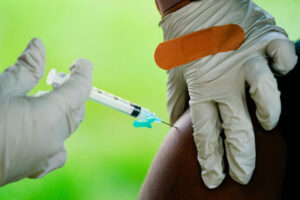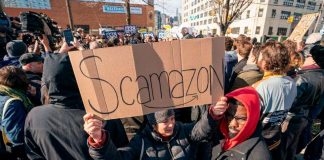APRIL 10, 2023

A health worker administers a dose of COVID-19 vaccine during a vaccination clinic in Reading, Pa. On Friday, Feb. 3, 2023. – Matt Rourke, AP
The Biden administration Monday announced a $5 billion program to accelerate the development of next-generation COVID-19 vaccines and treatments.
Like Operation Warp Speed, which developed and distributed vaccines in the early days of the pandemic, Project NextGen will cut across government agencies and involve public-private collaborations, a senior Biden official told USA TODAY.
Current vaccines, developed rapidly in the heat of the emergency, are “really good, but they’re not great,” said Michael Osterholm, an epidemiologist who worked with the administration to develop the new program. “There is a substantial amount of work (to be done) to take these good vaccines and hopefully achieve better vaccines.”
Project NextGen has three primary goals, which Osterholm and colleagues laid out in a “roadmap” issued in February: Develop a nasal vaccine that will hopefully prevent infection as well as severe disease; develop longer-lasting vaccines; and create “broader” vaccines that protect against all variants and several different coronaviruses
It will also include funding to develop more durable monoclonal antibodies resistant to new variants, according to the administration. Antibodies were highly effective treatments earlier in the pandemic but have not been able to keep up with the virus as it evolved and are no longer available.
What does long COVID do to kids? What we’ve learned after a year of research.
The administration said the initial allocation of $5 billion for Project NextGen will be financed through money saved from contracts costing less than originally estimated. The investment was first reported Monday by the Washington Post.
Dr. Gregory Poland, director of the Mayo Clinic’s Vaccine Research Group who was also involved in the earlier roadmap, said he and others have been advising the White House since last summer to launch something like Project NextGen.
The funding is a start he said, “but much more will be needed to accomplish all three goals,” he said. “The need though is urgent and now – something government generally doesn’t do well, hence the key will be prioritization and implementation.”
Why do we need new coronavirus vaccines?
When the current vaccines were developed, speed was a priority along with safety and effectiveness. They were 95% effective at preventing all disease when first released in late 2020. But their effectiveness against mild disease in particular wanes over just a handful of months.
Protection may also not be as good as the virus continues to evolve. The current bivalent booster is aimed at both the original virus and the BA.5 variant.
But SARS-CoV-2, the virus that causes COVID, is the third new coronavirus to pop up in the last two decades, following Middle-Eastern Respiratory Syndrome (MERS) and Severe Acute Respiratory (SARS). If and when a fourth turns up, it would be great to already have a vaccine that could protect against it, said Osterholm, who directs the Center for Infectious Disease Research and Policy at the University of Minnesota.
A nasal vaccine is the third item on the wish list. The idea is that by delivering a vaccine directly to the area where the virus enters the body, scientists could set up a barrier of protection to prevent even mild infections and transmission from one person to the next.
“I think an initiative like this is much needed and should have been put in place much sooner,” said John Moore, an immunologist at Weill Cornell Medical College in New York.
What happens next?
Reaching these goals will likely be more difficult than it sounds, Moore said.
“Anyone familiar with vaccine development knows that translation into a practical product is a much harder and more expensive process” than simply creating a basic vaccine, he said. “A lot of designs that look good in the early stages fizzle out because they cannot be manufactured efficiently under the conditions required for human trials.”
Dr. Paul Offit, a pediatrician who directs the Vaccine Education Center at Children’s Hospital of Philadelphia, is skeptical that any of these goals are realistic.
Researchers have been trying for more than 40 years to develop vaccines against multiple strains of flu and against HIV, the virus that causes AIDS. Both have proven elusive, he said, because the viruses mutate so much, as does SARS-CoV-2.
Meanwhile, nasal vaccines are still being tested in clinical trials, so it’s not yet clear how effective they’ll be against COVID. A nasal vaccine for the flu doesn’t provide any more protection than a shot, Offit said, and it’s most effective in young children who have never been exposed to the flu virus before. At this point, nearly every American has already been exposed to the virus that causes COVID.
Moore agrees that developing a nasal vaccine should be a high priority, but “it’s seriously naive to believe that it will be easy to make one.”
Offit worries that the emphasis on making COVID vaccines better will undermine public trust in the ones we already have. He said the current vaccines have been “amazing,” but that vaccines can only do so much.
What did Operation Warp Speed do?
Under the Trump administration, Operation Warp Speed spent about $30 billion beginning in March 2020 to develop, manufacture and distribute COVID-19 vaccines.
The federal government essentially placed bets on six different drug companies hoping at least a few of them would prove successful. Each received over $1 billion (although Pfizer/BioNTech developed its vaccine without government support) with a promise of a guaranteed market if they succeeded.
►Moderna and Pfizer/BioNTech both developed, tested, passed regulatory hurdles and produced millions of doses of their mRNA vaccines in under a year. Previously, the fastest vaccine had taken four years to bring to market.
►Johnson and Johnson also developed a vaccine based on a different technology. While effective, the vaccine led to a rare side effect and is no longer widely available in the United States.
►Novavax pursued a third type of vaccine technology and has also won emergency regulatory approval, though it is not widely available.
►The other two efforts, one by Sanofi and another by AstraZeneca, fell behind early and were not advanced beyond prelimitesting.
Courtesy/Source: This article originally appeared on USA TODAY

































































































